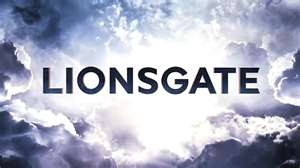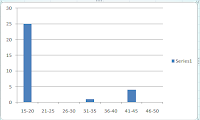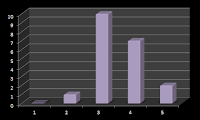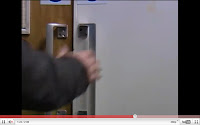(0 minutes 0 seconds - 1 minute 6 seconds)
- Our media product is both similar and different to the media products we analysed in lesson
- We used a linear narrative in order to accurately portray our plot line, as we felt that using a circular or non-linear narrative would confuse our audience
- We used concealment and protraction to create tension and audience interest, particularly in the shots of the hero bursting into the room where he believes that the girl is being held
- We originally decided to make a psychological thriller, but wanted to also include elements of the action thriller sub-genre to make our thriller fast-paced
- Therefore we tried to incorporate elements of both sub genres when creating our thriller
- We tried to follow as many codes and conventions of the thriller genre as we could
- These included: concealment and protraction, the transformed city, mazes and labyrinths and heroic romance
- We broke the conventions of the thriller genre by using shots of the killer at the beginning of our film, as we wanted to add tension of mystery to our thriller
- We followed the convention of having a male killer, as we wanted to conform to the expectations of our target audience
- We originally decided to film on three occasions: once in Warrington town centre, once inside Evans House and once outside of Evans House
- However, because of time restraints we filmed on more occasions
- We wanted to use high-angled shots of the girl in the room in order to make them look like CCTV footage, as if the killer was watching them
- We used canted angle shots to create and convey a sense of unease to our audience
- I think that our opening sequence is successful
- We managed to create tension, and audience interest
- I think that we used the codes and conventions of the thriller genre to good effect
What kind of media institution might distribute your media product and why?
I think that our film would be more likely to be shown in mainstream cinemas, as the thriller genre is a widely popular genre which benefits more and can be accessed better by its target audience through mainstream cinema as opposed to Art house cinemas, etc. I think that our film would work better being manually distributed in cinemas rather than being digitally distributed. This is because of the genre of film; thrillers are more effective and entertaining for the audience in a cinema because of the atmosphere. Therefore our film would be better received being distributed through cinemas rather than digitally.
A film distribution company is literally that; a company which distributes films to cinemas around the country, or even around the globe in order for them to reach their target audience. There are many examples of these companies: New Line Cinema, Warner Bros. Entertainment Inc. and Orion Pictures are just three distribution companies. I think that, from these three examples, our film Justice would most likely be distributed by New Line Cinema. New Line Cinema distributed the Se7en which is also a thriller, and is the same kind of thriller as Justice as there are elements of both the psychological and action sub genres of thriller.
I also explored independent and British film companies such as Lionsgate, Film 4 and Coffee Films when thinking about what film company would distribute our thriller. Coffee Films is an independent British film distributor which has been distributing films since 1996:
I considered Coffee Films as a possible distributor for our thriller, as it is a British Film company, and ours is a British film. Therefore, if our film was not popular enough to be distributed by Orion Pictures or New Line Cinemas a distribution company such as Coffee Films would be a good choice. Similarly, Lionsgate also distributes some independent thrillers, making this another option for a company to distribute our thriller Justice. Film 4 is another British film distributor that I could consider if I wanted our film to be distributed in the UK only. However, the obvious disadvantage to these companies is that they are smaller distributors, and therefore my thriller might not reach the majority of my target audience, as Justice may only by released in Britain or in certain cinemas.


However, I would not consider using a company such as Working Title films to distribute our film. This is because this company does not distribute thrillers generally, therefore making it less likely for our thriller to reach our target audience. Obviously, I would prefer for our thriller to be distributed by a bigger, more international film company such as Orion Pictures or New Line Cinema, as our film would reach more members of our target audience if distributed by this company.
I think that our film does not fully compare with professional films distributed by companies such as Orion Pictures or New Line Cinema, as it is not a professional film. However I do think that our film is as professional as we could make it with the equipment we used, and the previous experiences we had with filming and editing.
Who would be the audience for media product?

I considered Coffee Films as a possible distributor for our thriller, as it is a British Film company, and ours is a British film. Therefore, if our film was not popular enough to be distributed by Orion Pictures or New Line Cinemas a distribution company such as Coffee Films would be a good choice. Similarly, Lionsgate also distributes some independent thrillers, making this another option for a company to distribute our thriller Justice. Film 4 is another British film distributor that I could consider if I wanted our film to be distributed in the UK only. However, the obvious disadvantage to these companies is that they are smaller distributors, and therefore my thriller might not reach the majority of my target audience, as Justice may only by released in Britain or in certain cinemas.


However, I would not consider using a company such as Working Title films to distribute our film. This is because this company does not distribute thrillers generally, therefore making it less likely for our thriller to reach our target audience. Obviously, I would prefer for our thriller to be distributed by a bigger, more international film company such as Orion Pictures or New Line Cinema, as our film would reach more members of our target audience if distributed by this company.
I think that our film does not fully compare with professional films distributed by companies such as Orion Pictures or New Line Cinema, as it is not a professional film. However I do think that our film is as professional as we could make it with the equipment we used, and the previous experiences we had with filming and editing.
Who would be the audience for media product?
Our target audience is people aged 15-20 as they are the main body of people who took part in our audience questionnaire before we began to make our film. We took on board as much of the feedback that we received as we could, which helped us to choose what to put into our thriller. Although thrillers have a very broad audience, considering many people enjoy watching films from this genre, we received feedback mainly from people aged 15-20 so our results were biased towards that age group. We were already aware however that they thriller genre was very popular within this age group, meaning that we had already selected these as our target audience.


(male/female) (age ranges)


(male/female) (age ranges)
We chose to classify our film as a 15 because this would allow us the widest possible range all audiences and a 15 would ensure that our film would be able to reach our target audience of 15-20 year olds. It also means that we did not have to compromise the narrative of our thriller in any way, as we would have done if we had chosen a 12 certificate. This meant we could retain our narrative and reach our target audience.
As the thriller genre is a popular genre within all age ranges, I believe that it would appeal to people outside of our target audience. The narrative of our thriller (a young girl is abducted and her father must search through his past to find her and apprehend the villain) is not one which is particular to our target audience although we have created our thriller to aim at that age group. Therefore I think that people outside of our target audience would be interested in watching our thriller.
Examples of what memembers outside of our target audience said about our film:
Section 4 - Audience Research of my blog contains the target audience feedback we received http://rebecca-mediacoursework.blogspot.com/2010/11/section-5.html
How did you attract/address your audience?Examples of what memembers outside of our target audience said about our film:
Section 4 - Audience Research of my blog contains the target audience feedback we received http://rebecca-mediacoursework.blogspot.com/2010/11/section-5.html
We decided to involve some shots at the beginning of our film that would show the killer, as we knew from our audience feedback that what scares our target audience most in a thriller film in the character of the killer:
Question 9 - What scares you?
Out of the 30 people we asked, 8 replied that what scares them most about thriller films is the killer. This means that in creating our thriller, we need to ensure that we create the character of the killer so it lives up to the expectations of our target audience. Again, 13 people chose 'other' to answer this question, but as their answers were also specific to a particular thriller, we decided that the more generalized answer 'the killer' told us more about what our target audience expect from a thriller film.
Therefore, we knew that this would appeal to our target audience. Similarly, our target audience feedback told us that they preferred to see both younger and older characters in a thriller, so we knew the use of a younger victim, an older hero and an older killer would appeal:

We also chose to use a more claustrophobic location as one of the locations for our thriller because of the audience feedback we received; the room in which the girl is being kept hostage represents this claustrophobic location, although we also chose to use open locations, such as the building and the town centre where the hero runs through, as contrasts to the small room the victim is being kept in. I think that our completed production is suitable for our target audience in this way as we ensured that in making our thriller we went through our audience feedback, most of which was supplied by members of our target audience so our production meets these results.
When watching our film we wanted our target audience to feel sympathy for the victim in the room, as it becomes clear that she has been taken hostage and that the man running is trying to find her. We hoped to generate empathy and support for the man within our audience, as they would want him to find her whilst knowing that this was unlikely considering there must be some kind of narrative for the rest of the film.
I think that our target audience enjoyed our thriller; the audience feedback we received indicated that they felt that our thriller was a good example of an opening sequence. They seemed to think that the music we chose and the lighting that we used was effective:

Section 11: Audience Feedback of my blog shows all of the audience feedback that I received, including graphs for each question and a conclusion outlining what we understood from each question that we asked and the answers we were given. http://rebecca-mediacoursework.blogspot.com/2011/01/section-11-audience-feedback.html I think that our target audience enjoyed our thriller; the audience feedback we received indicated that they felt that our thriller was a good example of an opening sequence. They seemed to think that the music we chose and the lighting that we used was effective:


(music) (lighting)
They also felt that our editing was reasonably successful:What have you learnt about technologies from the process of constructing this product?
Looking back at preliminary task, what do you feel you have learnt in the progression from it to the full product?
I think that for our coursework film (right), the match on action shots worked better, partly because of the speed at which we edited them, and partly because we had more experience with filming and editing this type of shot.
Similarly, I think that from our prelim video (left) our use of low angled shots improved within our coursework film (right). This is again because we had more experience in editing and filming these shots.





























